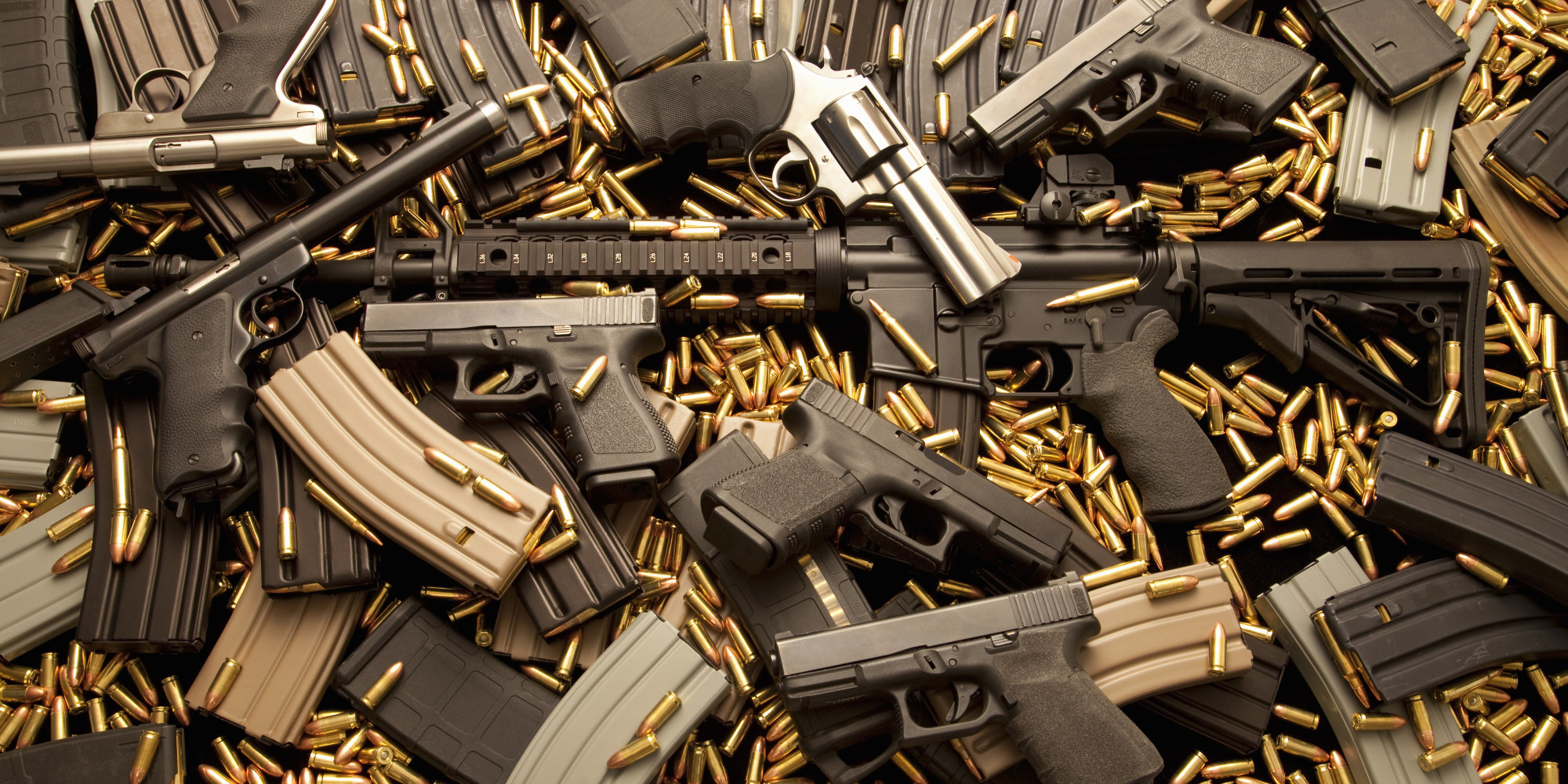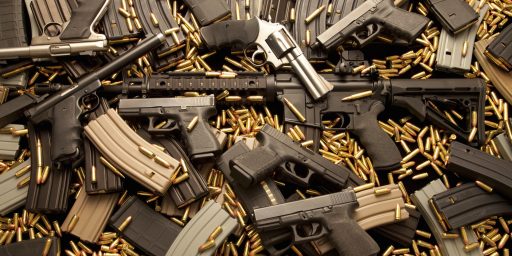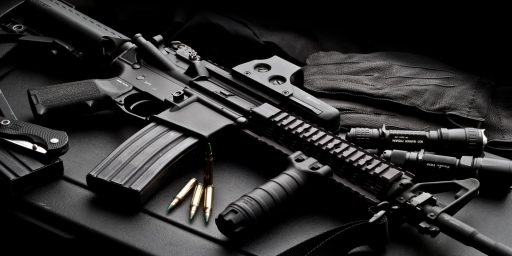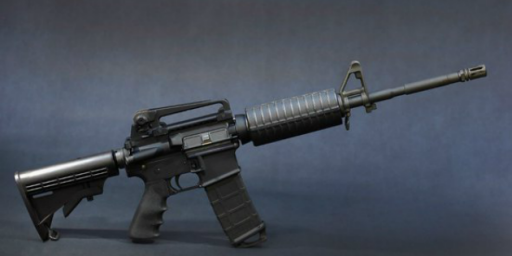Trump Administration Preparing To Ban Bump Stocks
The Trump Administration is preparing to ban bump stocks in the coming weeks.

The Trump Administration is reportedly prepared to ban bump stocks, a relatively inexpensive add-on to a semi-automatic weapon that essentially allows it perform in a manner similar to a fully automatic weapon:
WASHINGTON — The Trump administration is preparing to officially ban bump stocks on guns, a move that would put an end to the sale of attachments that allow semiautomatic rifles to fire faster and that would follow through on an order President Trump made this year to the Justice Department to regulate the devices.
An administration official said on Wednesday evening that a formal ban will be rolled out in the coming days to weeks, a timeline first reported by CNN. Mr. Trump, who has in recent weeks hinted that the ban would be coming, first called for the Justice Department to re-examine the regulations after a mass shooting in February at a Florida high school left 17 dead.
The president’s declaration set into motion a chain of events that surprised officials at the Bureau of Alcohol, Tobacco, Firearms and Explosives, which had already been tasked with reviewing whether the devices could be banned, a directive given after a massacre in Las Vegas in October 2017.
In that mass shooting, the deadliest in modern history, a gunman using weapons outfitted with a bump stock device killed 58 people. The gunman fired off about 90 rounds in 10 seconds.
As recently as last month, Mr. Trump said publicly that a ban would be coming.
“So we’re knocking out bump stocks,” the president said during a news conference announcing a revamped trade agreement with Canada. “I’ve told the N.R.A. I’ve told them: Bump stocks are gone.”
He added: “And over the next couple of weeks, I’ll be able to write it up.”
In the immediate aftermath of the massacre in Las Vegas that left 57 people dead and hundreds injured after a man using semi-automatic weapons equipped with bump stocks shot at a crowd gathered in an outdoor arena for a country music festival, there was much focus on these devices which were largely unknown even among people who are self-admitted gun hobbyists and enthusiasts. Even strong proponents of gun rights (see here, here, and here, for example) argued that there was no defensible reason for such devices to be legal, something I argued myself just a few days after the shooting. Many Republicans on Capitol Hill agreed, and at least publicly stated that they would be willing to move forward on Congressional action to ban the device. Additionally, polling showed that the American public as a whole was very supportive of the idea of banning these add-ons as well as other gun control measures. At the time at least, it seemed as though this would be one small gun control measure on which everyone could agree and that we could see quick action on the part of Congress on what seems like a fairly straightforward issue. Unfortunately, it soon became apparent that this initial optimism was misplaced. With the House and Senate both focused at the time on the Republican tax plan, the bump stock issue quickly faded from away and momentum on any kind of legislation on the issue slowed to a crawl on Capitol Hill. In the end, no action was taken on the issue and nobody seemed to notice. In the wake of the shooting in Parkland, Florida, though, attention was focused on the issue again and President Trump instructed the Justice Department to examine the issue and to issue a regulation banning the devices. This is what led to proposed regulations from the Justice Department, and it is these regulations that will apparently be formally adopted in the coming days or weeks.
From a legal point of view, it seems clear that a ban on bump stocks would clearly be acceptable under anything but the most unreasonable and unrelenting interpretation of the rights protected under the Second Amendment. in his majority opinion in District of Columbia v. Heller, which is essentially the first Supreme Court opinion to deal with the basic scope of the Second Amendment in its 200-year history, Justice Scalia made it clear that the Court was explicitly not finding that the right that the Amendment covers is unlimited or that the Amendment meant that there were no circumstances under which the Federal Government, states, or localities could regulate the types of weapons citizen could own or carry:
Like most rights, the right secured by the Second Amendment is not unlimited. From Blackstone through the 19th-century cases, commentators and courts routinely explained that the right was not a right to keep and carry any weapon whatsoever in any manner whatsoever and for whatever purpose. See, e.g., Sheldon, in 5 Blume 346; Rawle 123; Pomeroy 152-153; Abbott 333. For example, the majority of the 19th-century courts to consider the question held that prohibitions on carrying concealed weapons were lawful under the Second Amendment or state analogues. See, e.g., State v. Chandler, 5 La. Ann., at 489-490; Nunn v. State, 1 Ga., at 251; see generally 2 Kent *340, n. 2; The American Students’ Blackstone 84, n. 11 (G. Chase ed. 1884). Although we do not undertake an exhaustive historical analysis today of the full scope of the Second Amendment, nothing in our opinion should be taken to cast doubt on longstanding prohibitions on the possession of firearms by felons and the mentally ill, or laws forbidding the carrying of firearms in sensitive places such as schools and government buildings, or laws imposing conditions and qualifications on the commercial sale of arms.We also recognize another important limitation on the right to keep and carry arms. Miller said, as we have explained, that the sorts of weapons protected were those “in common use at the time.” 307 U. S., at 179. We think that limitation is fairly supported by the historical tradition of prohibiting the carrying of “dangerous and unusual weapons.” See 4 Blackstone 148-149 (1769); 3 B. Wilson, Works of the Honourable James Wilson 79 (1804); J. Dunlap, The New-York Justice 8 (1815); C. Humphreys, A Compendium of the Common Law in Force in Kentucky 482 (1822); 1 W. Russell, A Treatise on Crimes and Indictable Misdemeanors 271-272 (1831); H. Stephen, Summary of the Criminal Law 48 (1840); E. Lewis, An Abridgment of the Criminal Law of the United States 64 (1847); F. Wharton, A Treatise on the Criminal Law of the United States 726 (1852). See also State v. Langford, 10 N. C. 381, 383-384 (1824); O’Neill v. State, 16 Ala. 65, 67 (1849); English v. State, 35 Tex. 473, 476 (1871); State v. Lanier, 71 N. C. 288, 289 (1874).
We also recognize another important limitation on the right to keep and carry arms. Miller said, as we have explained, that the sorts of weapons protected were those “in common use at the time.” 307 U. S., at 179. We think that limitation is fairly supported by the historical tradition of prohibiting the carrying of “dangerous and unusual weapons.” See 4 Blackstone 148-149 (1769); 3 B. Wilson, Works of the Honourable James Wilson 79 (1804); J. Dunlap, The New-York Justice 8 (1815); C. Humphreys, A Compendium of the Common Law in Force in Kentucky 482 (1822); 1 W. Russell, A Treatise on Crimes and Indictable Misdemeanors 271-272 (1831); H. Stephen, Summary of the Criminal Law 48 (1840); E. Lewis, An Abridgment of the Criminal Law of the United States 64 (1847); F. Wharton, A Treatise on the Criminal Law of the United States 726 (1852). See also State v. Langford, 10 N. C. 381, 383-384 (1824); O’Neill v. State, 16 Ala. 65, 67 (1849); English v. State, 35 Tex. 473, 476 (1871); State v. Lanier, 71 N. C. 288, 289 (1874).
The Miller decision that Scalia makes reference to here is United States v. Miller, a 1939 ruling from the Supreme Court upholding a law enacted in 1934 which placed restrictions on the ownership of the machine guns (i.e., fully automatic weapons) of the day and heavily taxed their owners. Clearly, Scalia was intending to make it clear that Heller was not intended to overrule Miller and that it was also not intended to stand for the proposition that any regulation of weapons was per se invalid under the Second Amendment. Taken in that context, it seems clear that a regulation designed to prevent semiautomatic weapons from being converted to fully automatic weapons, which Miller clearly states are not protected by the Second Amendment, would be acceptable under Heller in addition to the fact that it just makes sense.




Credit where credit is due: Good on the trump admin (presuming they actually follow thru) Now it’s time to enshrine this common sense measure into law, right, Republicans? Right??
Will be interesting to see the legal theory used for the ban, so far stocks are not regulated gun parts.
And please read the 1934 NFA for once, it did not regulate (or tax) the owner of a machine gun, it regulated and taxed the transfer of ownership only. It not even had a mandatory registration requirement, that didn’t come until the 1968 GCA after the Kennedy assassinations.
Does the president have the power to do this without legislation, or is this just a setup to act like they’re trying to do something which fails miserably court and then they can shrug and say “well, we tried” without actually doing anything?
It’s the least they can do. Literally. The very least they can do.
@gVOR08:
“Well, no. the least they could do is nothing. But this is pretty easy. Should be back home in time for the game.” Cynical Kathy.
The question is whether this kind of ban can be enforced. The follow-up is “will it be enforced?”
That is a physical impossibility. If you listen to the audio in the article they are counting echos as gun fire…..
Only one of the guns had a bumpfire stock and it didn’t have a 90 round capacity drum in it or anywhere in the room.
EDIT : Don’t try to turn my statement into some kind of conspiracy theory about the shooter. He had the guns and the stuff to do it. I also don’t care to argue against or for bump stocks. I just wanted to point out a glaringly false statement by the New York Times.
@Matt: Indeed. I was trying to imagine some sort of belt-fed semi-auto with bumpstock.
@JohnMcC: Yeah you would need a belt feed or one of those very large drum mags (which tend to jam) AND jerk the crap out of the gun to get anywhere near that rate of fire. Bump stocks work via pulling/jerking the front gripping hand forward after each shot. I’ve fired a few platforms (AR/AK/ruger)that were equipped with a bumpstock over the years. The ruger 10/22 is the only one that I could be somewhat accurate with. I couldn’t reach anywhere near a 9 shot per second rate of fire with any of them.
Slidefire was the biggest manufacturer of bump stocks and they closed that down in June of this year. So it’s pretty hard to impossible to even buy one right now.
I’m not really sure how they can ban the stock without creating some legal issues. I’m just hoping they can do it without causing a bunch of stupid side effects.